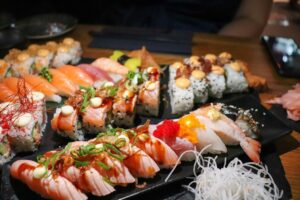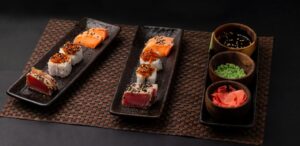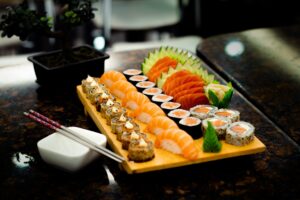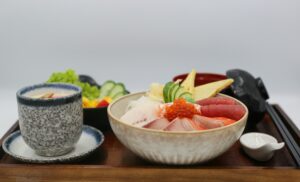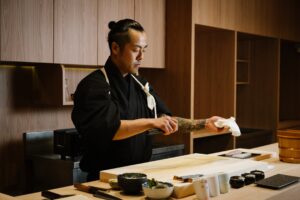
Japan Omakase: The Ultimate Guide to Chef’s Choice Dining
In the refined world of Japanese cuisine, few experiences rival the intimacy and artistry of Japan omakase dining. This revered tradition transforms a simple meal into a deeply personal culinary journey, where skilled artisans guide guests through a carefully orchestrated feast of seasonal ingredients and time-honored techniques.
At Sushi Masa, we embrace this ancient practice as the pinnacle of Japanese cuisine, offering diners an authentic glimpse into centuries of culinary wisdom. In recent years, foreign visitors have increasingly sought out omakase experiences as part of their culinary exploration in Japan, drawn by the unique blend of tradition and innovation.
Whether you’re a first timer curious about this legendary dining style or a seasoned enthusiast seeking to deepen your appreciation, understanding omakase opens doors to one of Japan’s most treasured cultural experiences. Restaurants in Japan are the primary venues for authentic omakase experiences, providing the perfect setting to enjoy this celebrated tradition. This comprehensive guide will prepare you for every aspect of your omakase journey, from proper etiquette to maximizing the artistry of each carefully crafted dish.
What is Japan Omakase?
The word “omakase” translates directly to “I leave it up to you,” stemming from the Japanese verb makaseru, meaning to entrust or leave in someone’s hands. In the context of dining, omakase represents the ultimate expression of trust between guest and sushi chef, where diners surrender all menu decisions to the culinary master’s expertise and creativity.

This chef’s choice dining experience centers on three fundamental principles: trust, surprise, and seasonality. The sushi chef curates each course based on the finest ingredients available that day, often sourced directly from venues like the famous Toyosu Market. Unlike regular restaurants where diners order from predetermined menus, omakase restaurants craft each meal as a unique performance, adjusting selections based on seasonal availability and individual guest preferences.
At omakase restaurants, guests dine at a carefully prepared counter table, often made of hinoki wood, which enhances the refined ambiance and serves as a central element of the experience. The dining experience unfolds at this table, where guests witness the chef directly preparing each piece with meticulous attention to technique and timing. This intimate setting allows for real-time customization – chefs observe reactions, note preferences, and adapt subsequent courses to create a truly personalized dining experience. The delicate balance of flavors, textures, and temperatures requires precise timing that only counter seating and the sacred table can accommodate.
The omakase meal typically progresses from lighter, more delicate flavors to richer, more complex preparations. Creative dishes may incorporate seasonal vegetables, special preparations like kombu-marinated fish, or rare ingredients that showcase the chef’s artistry. This progression ensures that each course complements rather than competes with the next, creating a harmonious whole experience that celebrates both tradition and innovation.

The Rich History and Evolution of Omakase Dining
The roots of omakase dining stretch back to Japan’s Edo period (1603-1868), when sushi began its transformation from humble street food to sophisticated cuisine. During this era, sushi vendors operated from portable stalls, serving fresh fish from wooden tubs to hungry passersby. The concept of leaving meal selection to the vendor emerged naturally – customers trusted these skilled practitioners to serve the day’s best catch.
The modern foundation of omakase can be traced to Hanaya Yohei, who revolutionized sushi in 1820s Tokyo by developing the nigiri style we recognize today. His innovation of placing seasoned rice beneath fresh fish created a new dining dynamic where the chef’s skill in balancing rice temperature, fish preparation, and timing became paramount. This period saw the emergence of the first true omakase experiences, where regular customers would simply say “omakase shimasu” – leave it to you.
Following World War II, Japan’s economic recovery transformed omakase from a practical necessity into a luxury dining experience. As high end restaurants emerged in Tokyo and other major cities, omakase evolved to showcase not just fresh seafood but the chef’s mastery of traditional techniques. The 1960s and 1970s saw the establishment of many legendary sushi counters that elevated omakase to an art form, emphasizing the theatrical aspects of preparation and the spiritual connection between chef and guest.
While omakase is renowned for its chef-driven, personalized approach, it is often contrasted with kaiseki, another high-end Japanese dining tradition. Kaiseki offers a multi-course meal focused on seasonal ingredients, artistic presentation, and a carefully curated progression of dishes, typically experienced in exclusive restaurant settings.
The 1980s and 1990s marked omakase’s golden age of refinement, coinciding with Japan’s economic boom. During this period, the most prestigious venues began incorporating rare and expensive ingredients, extending meal duration, and developing the sophisticated etiquette and presentation standards that define modern omakase. The Michelin Guide’s eventual recognition of Japanese establishments, and its role as a trusted authority for discovering top omakase and kaiseki restaurants, further elevated omakase’s international reputation.
At Sushi Masa, our culinary philosophy is guided by profound respect: tradition should inspire, not limit. Chef Masa, a Tokyo native with 16 years of experience honed through rigorous apprenticeship, connects guests to this rich culinary lineage through precise, time-honored techniques. Yet, every omakase journey embraces contemporary innovation, allowing for artful and unexpected flavors.
What to Expect During Your Omakase Experience
Your omakase experience begins the moment you’re seated at the counter, where the sushi chef will personally greet you and begin crafting your meal. Omakase sushi is a premium, personalized sushi experience curated by the chef, emphasizing craftsmanship, exclusivity, and a unique culinary journey. The entire experience typically unfolds over 90 to 120 minutes, during which you’ll enjoy between 12 to 18 carefully sequenced courses. Each dish arrives at the precise moment it’s meant to be consumed, with rice at its optimal temperature and fish prepared to highlight its peak flavor. Be sure to eat each piece promptly after it is served to fully appreciate the chef’s skill and the intended flavors.

The meal opens with lighter preparations designed to awaken your palate. You might begin with delicate sea bream or flounder, simply prepared to showcase the fish’s natural sweetness. The chef will often explain the origin of each ingredient – perhaps wild-caught from specific Japanese waters or selected from that morning’s market. These initial courses establish the meal’s rhythm and allow the chef to gauge your preferences and reactions.
As the omakase meal progresses, flavors intensify and preparations become more complex. Mid-course selections might include yellowtail with a touch of citrus, or mackerel that’s been lightly cured to concentrate its flavor. The chef’s expertise shines through subtle variations in rice preparation – slightly warmer rice for certain fish, different vinegar balances to complement specific flavors, and precise seasoning that enhances without overwhelming.
The climax typically features the evening’s most prized ingredients. Premium tuna preparations showcase the chef’s knife skills and understanding of different cuts – lean akami, medium-fatty chutoro, and the prized otoro belly. Sea urchin (uni) often appears near the meal’s end, its creamy richness perfectly balanced against seasoned rice. These luxury ingredients demonstrate why omakase represents such exceptional value, as individual pieces might cost significantly more when ordered separately.
The conclusion usually features cooked preparations like anago (sea eel) or a signature tamago (sweet egg custard), followed by a warming miso soup and perhaps seasonal fruit. Throughout the meal, the chef may offer sake pairings selected to complement specific courses, enhancing flavors and providing cultural context for traditional combinations.
Omakase Etiquette and Preparation
Here are some essential tips to ensure you make the most of your omakase experience.
Proper preparation enhances your omakase experience and demonstrates respect for this revered tradition. Your attire should reflect the occasion’s significance – smart casual represents the minimum, while many guests choose business casual or formal dress for dinner service. Avoid strong fragrances that might interfere with the delicate aromas of fresh fish and seasoned rice.
Punctuality is crucial in omakase dining, as chefs time each course precisely and late arrivals disrupt the entire service flow. Most omakase restaurants maintain strict policies requiring guests to arrive within 15 minutes of their reservation time. If delays are unavoidable, call immediately to discuss options, though many popular restaurants cannot accommodate significant lateness due to limited counter seats and carefully scheduled service.
Communication about dietary restrictions and allergies must occur during booking, not upon arrival. While skilled chefs can often accommodate preferences, certain restrictions may be incompatible with traditional omakase service. Be honest about your comfort level with raw fish, shellfish allergies, or strong preferences against specific ingredients. This advance notice allows chefs to plan alternative preparations without disrupting service flow.
Photography guidelines vary among restaurants, but general principles apply universally. Never use flash, which disrupts other diners and affects the chef’s concentration. Ask permission before photographing, and avoid elaborate food styling that delays consumption. Remember that sushi is meant to be eaten immediately when served – the chef’s timing depends on your prompt consumption of each piece.
Building rapport with your sushi chef enhances the experience significantly, but approach interaction thoughtfully. Brief expressions of appreciation are always welcome, and asking about specific ingredients shows genuine interest. However, avoid lengthy conversations during busy service periods, and never request detailed explanations that delay other guests’ service. Most importantly, relax and enjoy the meal—letting go of stress allows you to fully appreciate the chef’s artistry and the element of surprise that makes omakase special.
Fine Dining Etiquette at the Sushi Counter
Counter seating etiquette reflects centuries of refined tradition while ensuring optimal enjoyment for all guests. When each piece arrives, consume it immediately – the chef has calculated precise timing for rice temperature, fish texture, and overall flavor balance. Delaying consumption compromises these carefully calibrated elements.
Using fingers versus chopsticks depends on the specific dish and your comfort level. Traditional nigiri sushi is often eaten by hand, allowing better control and preventing rice from separating. Turn the piece fish-side down when dipping in soy sauce, avoiding oversaturation that masks the fish’s natural flavor. Many pieces come pre-seasoned and require no additional soy sauce.
Sake pairing, when offered, follows specific timing that complements the meal’s progression. Accept pairings graciously and sip thoughtfully – the chef selects specific varieties to enhance particular courses. If you prefer to decline alcohol, do so politely during initial conversation rather than after pairings are poured.
Showing appreciation to the chef requires subtle but meaningful gestures. A simple “oishii” (delicious) or “arigato gozaimasu” (thank you very much) demonstrates respect without demanding response. Maintain eye contact when the chef explains dishes, and offer a respectful bow when departing. Generous tipping, while not traditionally Japanese, is appreciated in international establishments.
Your dining companions should be equally mindful of counter etiquette. Avoid discussions that distract from the culinary performance, and ensure that everyone in your party understands the experience’s contemplative nature. Large groups may find private room options more suitable for extensive conversation.
Understanding Omakase Pricing and Value
Premium ingredient costs represent the most significant expense, as chefs source the finest available fish, often purchasing specific pieces from daily market auctions. Toyosu Market’s tuna auctions can see individual fish selling for thousands of dollars, with omakase restaurants competing for the choicest cuts. Many diners choose to splurge on omakase for special occasions or as a memorable treat, appreciating the unique and luxurious experience it offers.
The investment in skilled chef training justifies substantial pricing premiums. Master sushi chefs undergo decade-long apprenticeships learning knife techniques, rice preparation, seasonal timing, and customer interaction.
Seasonal availability dramatically influences costs, as the finest ingredients appear only during specific periods. Wild bluefin tuna commands peak prices during optimal seasons, while prized uni varies significantly based on harvest timing and origin. Omakase restaurants must balance consistent quality with fluctuating ingredient costs, often absorbing seasonal premiums to maintain stable pricing.
A few tips for getting the best value from your omakase experience: consider booking a lunch service, which is often more affordable than dinner, and research seasonal specialties to enjoy peak ingredients at their best.
At fine dining establishments like Sushi Masa, omakase pricing reflects our commitment to authenticity and excellence. We maintain relationships with premium suppliers, invest in continuous chef training, and source ingredients that honor traditional standards.
While pricing may seem substantial compared to conventional dining, the experience represents exceptional value when considering ingredient quality, chef expertise, and cultural authenticity.
Making Reservations Successfully
Advance booking requirements vary but generally need one to four weeks’ notice for popular omakase restaurants, with top venues often booking months ahead, especially for weekend dinners. Planning ahead helps secure counter seats and shows your commitment to experiencing authentic japan omakase.
Cancellation policies protect small restaurants from no-shows; many require credit card guarantees or full prepayment with strict deadlines. Understanding these policies avoids penalties and maintains good relations with high end restaurants.
Special occasions like birthdays or anniversaries benefit from advance notice to arrange private rooms or special service. Communicating your needs during booking ensures better service and a memorable dining experience.
Language barriers are less daunting now, as many restaurants in japan offer English support or translated menus. Learning basic Japanese phrases enhances interaction with the sushi chef and enriches your omakase dining experience.

Regional Variations in Japanese Omakase
Tokyo’s Edo-Style Omakase
Tokyo’s Edo-style omakase represents the most widely recognized format, emphasizing technical precision, premium ingredients, and minimal embellishment. This style prioritizes the pure flavor of exceptional fish, precisely seasoned rice, and masterful knife work. Tokyo establishments often feature the most expensive ingredients and formal service protocols that reflect the capital’s sophisticated dining culture.
Osaka and Kyoto
Osaka and Kyoto offer distinctly different approaches that reflect regional culinary preferences. Osaka’s merchant culture influenced a more approachable, value-conscious omakase style that emphasizes flavor intensity and generous portions. Kyoto’s imperial heritage created refined, subtle preparations that showcase seasonal awareness and artistic presentation over raw luxury.
Coastal Regions
Coastal regions throughout Japan develop specialties based on local seafood availability. Hokkaido’s cold waters produce exceptional uni and crab that feature prominently in regional omakase. Southern regions might emphasize different fish varieties or preparation techniques that reflect local preferences and traditional methods.
Modern Fusion
Modern fusion approaches in international markets adapt omakase principles to local tastes and ingredient availability. These variations may incorporate non-Japanese elements while maintaining core principles of seasonal awareness, chef expertise, and progressive flavor development. Success depends on respecting fundamental concepts while adapting to local contexts.
International Omakase Restaurants
International omakase restaurants honor Japanese traditions through authentic training, ingredient sourcing, and service protocols. The best establishments maintain relationships with Japanese suppliers, employ traditionally trained chefs, and educate guests about cultural context. This authenticity ensures that omakase experiences outside Japan still provide meaningful cultural education.
Traditional vs Contemporary Interpretations
Traditional versus contemporary interpretations create ongoing discussions within the culinary community. Purists advocate for strict adherence to established methods and ingredients, while innovators explore modern techniques and global influences. Both approaches have merit when executed with skill and respect for underlying principles.
Maximizing Your Omakase Experience
Arriving with an open mind and healthy appetite sets the foundation for optimal enjoyment. Omakase works best when guests trust the chef’s expertise and remain receptive to new flavors and preparations. Preconceived notions about specific fish or preparation styles can limit appreciation and prevent discovery of new favorites.
Building rapport with the sushi chef enhances personalization and creates memorable interactions. Express genuine interest in ingredients and preparation methods through thoughtful questions that demonstrate respect rather than challenging expertise. Chefs appreciate guests who show curiosity about their craft and cultural traditions.

At Sushi Masa, our chefs excel at reading guest preferences and adapting service to individual comfort levels. We encourage questions and cultural exchange while maintaining the contemplative atmosphere that defines authentic Japanese omakase. Our goal is ensuring every guest leaves with deeper appreciation for Japanese culinary traditions and memories that inspire return visits.
The omakase tradition represents more than exceptional dining – it embodies Japanese values of trust, seasonal awareness, and artistic excellence. Whether you’re planning your first omakase experience or seeking to deepen your appreciation, approaching this tradition with respect and openness ensures transformative dining that transcends ordinary meals.
We invite you to discover the artistry and cultural richness of authentic Japan omakase at Sushi Masa, where centuries of tradition meet contemporary excellence. Book your reservation to embark on a culinary journey that celebrates the finest aspects of Japanese cuisine and creates lasting memories through the timeless bond between chef and guest.

